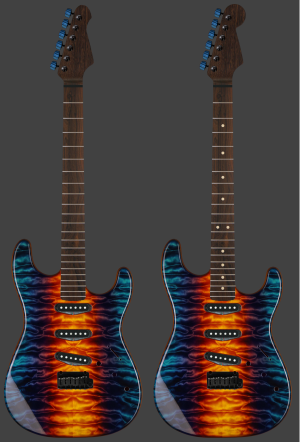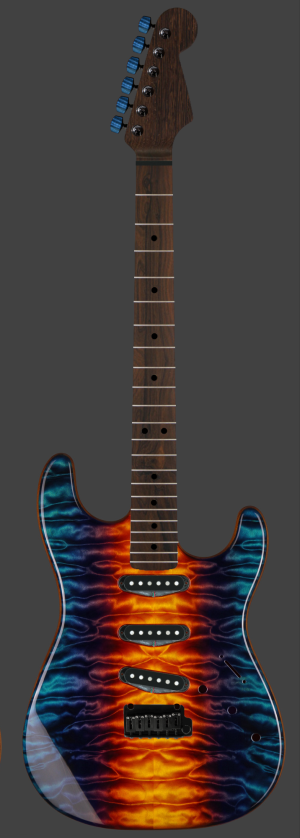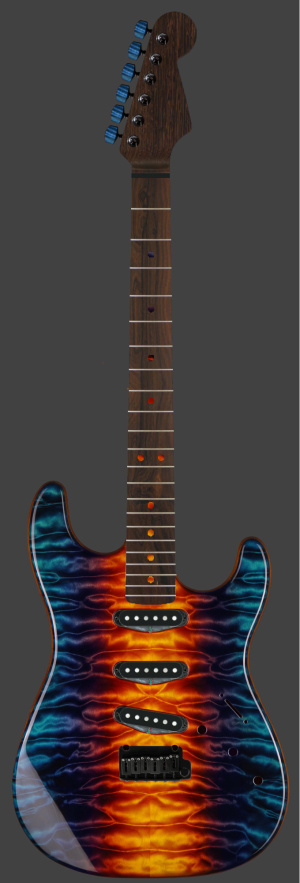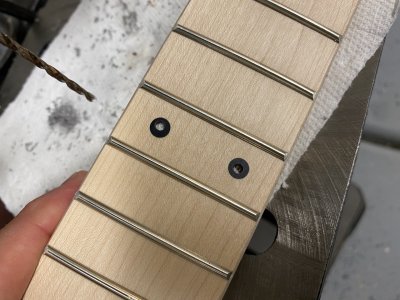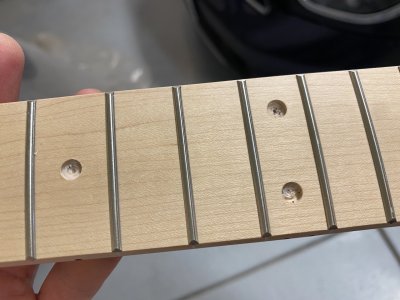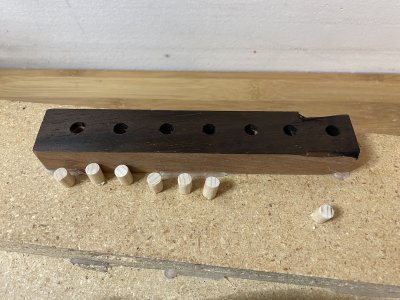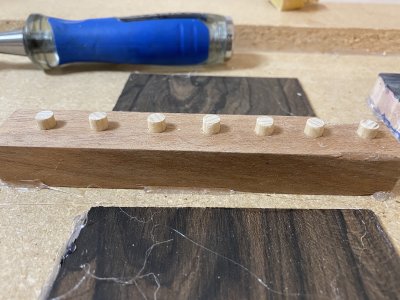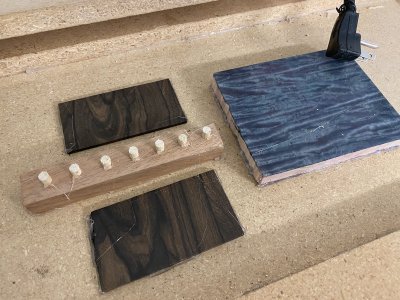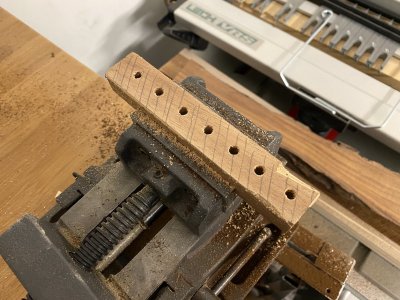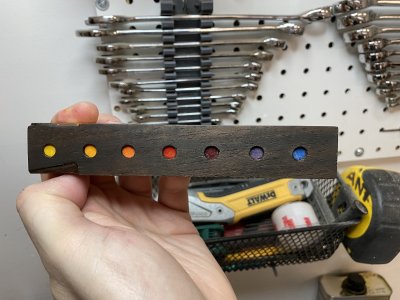
You are using an out of date browser. It may not display this or other websites correctly.
You should upgrade or use an alternative browser.
You should upgrade or use an alternative browser.
Pele fade Strat build
- Thread starter docteurseb
- Start date
docteurseb
Hero Member
- Messages
- 774
JaySwear2 said:Glad you’re making the decisions and not me. Normally I don’t think it looks great on a Strat but I really love the Warmoth headstock here! Especially with that truss rod cover.
JaySwear2 said:Glad you’re making the decisions and not me. Normally I don’t think it looks great on a Strat but I really love the Warmoth headstock here! Especially with that truss rod cover.
The main thing holding me back is the nightmare I had cutting a nut for my last 3+3 headstock to keep it stable with tremolo use.
There are couple interesting options from the showcase worth considering:
https://www.warmoth.com/Showcase/images/necks/large/WN2391A.jpg
Pros: no inlays, cheap way to find out how I like Standard Thing (it's been a while since I had one).
Cons: bright maple headstock, I could try putting a veneer but that could become an expensive experiment. Still traumatized by having to cut a dozen nuts for my last 3+3 neck to get decent tuning stability.
https://www.warmoth.com/Showcase/ShowcaseNeck.aspx?Body=1&Shape=1&Path=Strat&fWood=56&i=SN27757#.XneeKS2ZNTY
This is the neck used for those renderings (except the headstock on the Warmoth rendering).
Pros: ready, not horribly expensive, perfect color matching between neck and fingerboard (draw of the luck if I go with a custom order).
Cons: Strat headstock (not supposed to use that on a non Fender body, and the Warhead headstock looks better to me in this case), dot inlays which draw attention a little bit, Wenge so it could tend to be neck heavy with this body (probably OK since it's standard thin and I'm planning to use wood buttons).
Attachments
docteurseb
Hero Member
- Messages
- 774
With a custom order I would probably request a peghead veneer. That showcase neck is color-wise perfect despite using different woods, that's rare.
Headstock shape aside, replacing the dots shouldn't be too horrible and I think I have a decent way to keep them flush radiused with the same Dremel inlay routing base I have (using the frets as support). I'm going to try that on the $20 scrap neck I have for these kind of experiments.
Imagine stained maple dot inlays :
:
Headstock shape aside, replacing the dots shouldn't be too horrible and I think I have a decent way to keep them flush radiused with the same Dremel inlay routing base I have (using the frets as support). I'm going to try that on the $20 scrap neck I have for these kind of experiments.
Imagine stained maple dot inlays
Attachments
Verne Bunsen
Hero Member
- Messages
- 2,472
docteurseb
Hero Member
- Messages
- 774
Just experimented removing dots from the scrap neck ($20 including shipping from China, it's as good as you can imagine).
It went well though I gave up removing all of the white glue at the bottom of the holes.
Filled with colored epoxy, I'll test resurfacing this using the dremel+inlay base (Stewmac) in a few days.
Couldn't find curly maple dots. Plain maple ones from Stewmac would probably be visually equivalent on such a small surface area.
It went well though I gave up removing all of the white glue at the bottom of the holes.
Filled with colored epoxy, I'll test resurfacing this using the dremel+inlay base (Stewmac) in a few days.
Couldn't find curly maple dots. Plain maple ones from Stewmac would probably be visually equivalent on such a small surface area.
Attachments
PhilHill
Hero Member
- Messages
- 1,653
docteurseb said:Just experimented removing dots from the scrap neck ($20 including shipping from China, it's as good as you can imagine).
It went well though I gave up removing all of the white glue at the bottom of the holes.
Filled with colored epoxy, I'll test resurfacing this using the dremel+inlay base (Stewmac) in a few days.
Couldn't find curly maple dots. Plain maple ones from Stewmac would probably be visually equivalent on such a small surface area.
I have found that the plastic variety of pearloid and abalone dots will take stain, it doesn't penetrate deeply though, so it wouldn't take much sanding to remove it.
docteurseb
Hero Member
- Messages
- 774
If I go that route the maple dots would have to be recessed: stain them first, install, glue, fill with epoxy, sand/surface flush and buff.
That's what PRS does on their Private Stock models with stained curly maple inlays.
That's what PRS does on their Private Stock models with stained curly maple inlays.
stratamania
Mythical Status
- Messages
- 12,277
The body speaks for itself so personally I think no inlays and plain ebony knobs on the tuners would look better.
Cagey
Mythical Status
- Messages
- 24,425
I think that's the way I'd go. I have several guitars without fretboard face inlays, and it took all of about 8 seconds to get used to it. You need markers - at least I do - but the side markers are plenty. Of course, those can be a difficult to impossible to see on dark stages, but that's not a huge problem for many. Performers could to the glow-in-the-dark thing or big face markers or something.
docteurseb
Hero Member
- Messages
- 774
I have two necks without inlays and like those, but I suppose I'm just always tempted to try new things, and doing inlays like this is very fun (and potentially expensive if the experiment goes south...).
I also really like that Strat showcase neck. The fingerboard grain is really nice and the colors between wenge and ziricote match so well in this case that I don't think I'd have anything as good via custom order.
I also really like that Strat showcase neck. The fingerboard grain is really nice and the colors between wenge and ziricote match so well in this case that I don't think I'd have anything as good via custom order.
docteurseb
Hero Member
- Messages
- 774
Tried a few methods for getting the epoxy-filled holes flush with the fingerboard:
- Dremel with StewMac base for inlays and using frets as support: terrible idea :laughing7:
- Chisel: worked well for one of the dots, but make a small mistake and you easily leave deep marks into the fingerboard.
- razor blade + tape (leaving only the center with the blade exposed): nice flush surface without any marks on the fingerboard. looks good if the epoxy is hard and without bubbles.
This would be the way to go.
- Dremel with StewMac base for inlays and using frets as support: terrible idea :laughing7:
- Chisel: worked well for one of the dots, but make a small mistake and you easily leave deep marks into the fingerboard.
- razor blade + tape (leaving only the center with the blade exposed): nice flush surface without any marks on the fingerboard. looks good if the epoxy is hard and without bubbles.
This would be the way to go.
docteurseb
Hero Member
- Messages
- 774
Ordered that neck after all... I don't know yet if I'll replace the dots, for now I want to see if standard thin is something I'll really like and whether the wenge neck is going to make this guitar neck heavy.
Worst case I think I can easily break even on this neck once I do the usual rolled fingerboard edges treatment (a painful/long process).
Worst case I think I can easily break even on this neck once I do the usual rolled fingerboard edges treatment (a painful/long process).
Hendrix
Hero Member
- Messages
- 710
docteurseb said:So it's down to 1, 2 or 4 for me in this latest round of pictures.
My picks aren't what I would have expected prior to doing the renderings, glad I did it in this case. It's such an unusual finish it's bit hard to visualize otherwise.
I like 4 with blue buttons.
docteurseb
Hero Member
- Messages
- 774
Looks like I shouldn't expect the body and neck anytime soon, so I have plenty of time now to practice with stained maple dots inlays.
Found 1/4 poplar dowels at Lowe's.
Drilled a scrap piece of mahogany and radius-sanded it.
I couldn't cleanly cut the dowels with a saw (massive tear out), so instead I ended up surfacing them with a router. There was still some tear out but it's completely fine for this experiment.
To make the mahogany piece look similar to RW/Ziricote I applied some walnut transtint dye.
Next steps: stain the dowels, recess them, fill with clear epoxy, scrap the epoxy flush and buff it.
Found 1/4 poplar dowels at Lowe's.
Drilled a scrap piece of mahogany and radius-sanded it.
I couldn't cleanly cut the dowels with a saw (massive tear out), so instead I ended up surfacing them with a router. There was still some tear out but it's completely fine for this experiment.
To make the mahogany piece look similar to RW/Ziricote I applied some walnut transtint dye.
Next steps: stain the dowels, recess them, fill with clear epoxy, scrap the epoxy flush and buff it.
Attachments
docteurseb
Hero Member
- Messages
- 774
Cagey
Mythical Status
- Messages
- 24,425
Before you give up, a couple things to consider...
You can buy "plug cutters" from the usual suspects who do drills and other cutting tools, which allows you to make round pieces of wood from any kind of wood you can get. Slice off pieces of that to make unique dots. Another surprising source of dots and other inlays is billiard supply houses. On the better tables the side markers for gauging bank shots can be of somewhat unusual shapes/materials.
Finally, rather than use a razor for scraping, consider a regular scraper and the burnishing tool to put a proper edge on it. Makes leveling a bit easier, although there's some risk of distorting the fretboard surface.
You can buy "plug cutters" from the usual suspects who do drills and other cutting tools, which allows you to make round pieces of wood from any kind of wood you can get. Slice off pieces of that to make unique dots. Another surprising source of dots and other inlays is billiard supply houses. On the better tables the side markers for gauging bank shots can be of somewhat unusual shapes/materials.
Finally, rather than use a razor for scraping, consider a regular scraper and the burnishing tool to put a proper edge on it. Makes leveling a bit easier, although there's some risk of distorting the fretboard surface.
docteurseb
Hero Member
- Messages
- 774
THANK YOU!
Had been looking for that kind of tool without knowing how it was called. The only thing I had found was 'hole saw' which don't work for this.
Stained curly maple will likely look far better (works great on PRS Guitars).
These popular dowels are so uniform boring looking that they look like toys with these stains.
As you can seen from the pics I have some scrap of curly maple I can use for this, hopefully I can find one of these plug cutters around here.
Had been looking for that kind of tool without knowing how it was called. The only thing I had found was 'hole saw' which don't work for this.
Stained curly maple will likely look far better (works great on PRS Guitars).
These popular dowels are so uniform boring looking that they look like toys with these stains.
As you can seen from the pics I have some scrap of curly maple I can use for this, hopefully I can find one of these plug cutters around here.
Similar threads
- Replies
- 19
- Views
- 2K
- Replies
- 12
- Views
- 3K
- Replies
- 33
- Views
- 6K
- Replies
- 95
- Views
- 21K


